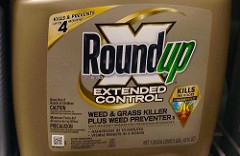written by Elise Miller, EdM
Director
 The scientific evidence is mounting that glyphosate-based herbicides, which are the most heavily applied in the world, may not be the panacea for feeding the world’s hungry as its proponents have argued. A year ago the World Health Organization’s International Agency for Research on Cancer (IARC) concluded that glyphosate (also known by “Roundup”, one of its brand names) is “probably carcinogenic to humans.” Last month, over a dozen researchers published a Statement of Concern, asserting that regulations have not kept up with the emerging science on links between glyphosate exposure and human health concerns, particularly in light of the 100-fold increase in the use of the herbicide since the late 1970s. Just this past Monday, a new biomonitoring study was published that found the vast majority of Germans have glyphosate residues in their bodies, and a third of the population has levels 10 to 42 times higher than what is currently considered a safe threshold of exposure.
The scientific evidence is mounting that glyphosate-based herbicides, which are the most heavily applied in the world, may not be the panacea for feeding the world’s hungry as its proponents have argued. A year ago the World Health Organization’s International Agency for Research on Cancer (IARC) concluded that glyphosate (also known by “Roundup”, one of its brand names) is “probably carcinogenic to humans.” Last month, over a dozen researchers published a Statement of Concern, asserting that regulations have not kept up with the emerging science on links between glyphosate exposure and human health concerns, particularly in light of the 100-fold increase in the use of the herbicide since the late 1970s. Just this past Monday, a new biomonitoring study was published that found the vast majority of Germans have glyphosate residues in their bodies, and a third of the population has levels 10 to 42 times higher than what is currently considered a safe threshold of exposure.
But this doesn’t necessarily mean that glyphosate is going off the market any time soon. Right now experts are arguing before the EU Parliament as to whether or not to re-approve the use of Roundup. The decision needs to be made by June, but yesterday there was a report that several leading European countries now plan to vote against the re-approval. In the US, this fight would inevitably be even tougher given the anti-regulatory climate in Washington, DC. And so it goes.


I appreciate the many positive notes I’ve received from a number of colleagues for this blog, along with some other suggested resources related to glyphosate. This is not intended to be an exhaustive list in any way (particularly given how rapidly this story is moving), but here are a few more links of note:
Elise Miller, CHE Director